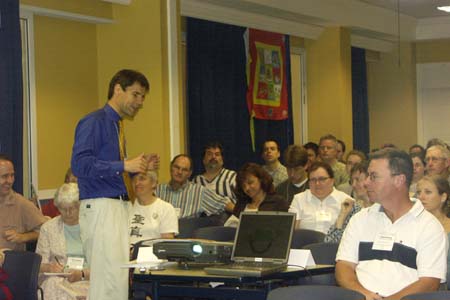
RETHINKING DEVELOPMENT
Local Pathways to Global Wellbeing
St. Francis Xavier University, Antigonish, Nova Scotia, Canada
June 20 to June 24, 2005
Ecological Footprint
Presenters:
Mathis Wackernagel
Rapporteur: Johannes Hirata
The Ecological Footprint (EF): What's in it for you?
Goal of workshop: learn about the tool of the EF and know how to use it. The EF is a measure of (a) how much nature we have (supply) and (b) how much we use (demand). It's about the question whether we fit on the planet.
Supply side:
"Natural step": man transforms natural resources into waste and nature turns waste into natural resources (food). Like with finances, we cannot, in the long run, take out more than goes in.
The world's surface has 51 bn hectares (1 ha = 2.5 acres). Of this, only about a quarter is productive surface. Dividing this surface (12 bn ha) by world population gives about 1.8 ha per person (without putting aside surface for other species).
Demand side:
When we translate our resource use into surface use, how much are we using? You can translate non-surface use into surface by estimating how big an earth would be required to sustain current levels of resource use or waste disposal (e.g., CO2 emmissions).
Calculating the world global footprint gives an average of 2.2 ha per person which compares to a capacity of 1.8 ha. This implies that we are "borrowing" natural capacity from nature's future. CO2 accounts for about half of the footprint.
The World Wildlife Fund is using the EF concept to communicate natural limits.
The EF itself says nothing about sustainability or about what people must do. It only say how much space is available on a sustainable basis and how much people in different places are using.
The future will not be divided between developing and developed countries. Rather, it will be divied between ecological creditors and ecological debtors. In this perspective, the US, UK but also Bangladesh and Egypt would be debtors, and Russia, Brazil, Canada would be creditors. A debtor country would be one that is using more than its own space to sustain itself, even if it uses less than 1.8 ha per person. Creditor and debtor countries can "trade" biocapacity among each other, but the Earth cannot trade with a creditor planet.
Like GDP, we need a standardized, precise measurement of natural limits. People are invited to subscribe to the EF newsletter and to join the network www.footprintnetweork.org.

Nation Building and Environmental Sustainability
Overview :: Presenters :: Proceedings :: Papers :: Home
Sealevel
Photography courtesy Patch of Blue by Stella McNeil.